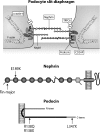Congenital nephrotic syndrome and recurrence of proteinuria after renal transplantation
- PMID: 24682440
- PMCID: PMC4212136
- DOI: 10.1007/s00467-014-2781-z
Congenital nephrotic syndrome and recurrence of proteinuria after renal transplantation
Abstract
Renal transplantation (RTx) is the only curative treatment for most cases of congenital and infantile nephrotic syndrome (NS) caused by genetic defects in glomerular podocyte proteins. The outcome of RTx in these children is usually excellent, with no recurrence of nephrotic syndrome. A subgroup of patients with the Finnish type of congenital nephrosis (CNF), shows, however, a clear risk for post-RTx proteinuria. Most of these patients have a homozygous truncating mutation (Fin-major mutation) in the nephrin gene (NPHS1), leading to total absence of the major podocyte protein, nephrin. After RTx, these patients develop anti-nephrin antibodies resulting in nephrotic range proteinuria. Plasma exchange combined with cyclophosphamide and anti-CD20 antibodies has proved to be successful therapy for these episodes. NS recurrence has also occurred in a few patients with mutations in the podocin gene (NPHS2). No anti-podocin antibodies have been detectable, and the pathophysiology of the recurrence remains open. While most of these episodes have resolved, the optimal therapy remains to be determined.
Figures

References
-
- Jalanko H, Holmberg C. Congenital nephrotic syndrome. In: Avner D-D, Harmon W-E, Niaudet P, Yoshikawa N, editors. Pediatric Nephrology. 6. Berlin Heidelberg New York: Springer; 2009. pp. S601–S619.
-
- Ahvenainen EK, Hallman N, Hjelt L. Nephrotic syndrome in newborn and young infants. Ann Paediatr Fenn. 1956;2:227–241. - PubMed
-
- Kestilä M, Lenkkeri U, Männikkö M, Lamerdin J, McCready P, Putaala H, Ruotsalainen V, Morita T, Nissinen M, Herva R, Kashtan CE, Peltonen L, Holmberg C, Olsen A, Tryggvason K. Positionally cloned gene for a novel protein—nephrin—is mutated in congenital nephrotic syndrome. Mol Cell. 1998;1:575–582. doi: 10.1016/S1097-2765(00)80057-X. - DOI - PubMed
Publication types
MeSH terms
Substances
Supplementary concepts
LinkOut - more resources
Full Text Sources
Other Literature Sources
Medical
Miscellaneous

